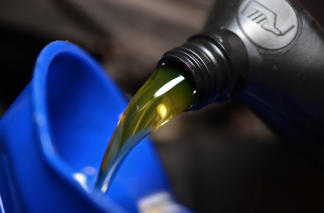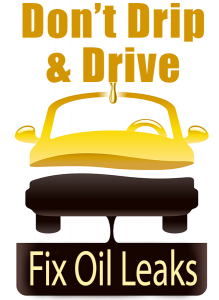Pollution Prevention for Automotive Repair Industries
 Stormwater Pollution
Stormwater Pollution
The Town of Sudbury, like many municipalities across the country, operates a “municipal separate stormwater drainage system” or MS4, which is designed to convey discharges that are composed entirely of stormwater and is separate from the wastewater sewer system that conveys discharges from individual homes or businesses. It is important to note that MS4 stormwater discharges receive no formal treatment and flow directly into our community’s stormwater drainage system and into our local waterways.
Poor training and material management practices at automotive body repair and vehicle washing industry locations can cause pollutants such as detergents, cleansers, solvents, and paint waste to enter our stormwater system. These pollutants can build up in stormwater lines and cause blockages, negatively impact the operation of stormwater retention areas and drywells, or degrade the water quality of our washes and rivers. Pathways of this pollution include the direct pouring or dumping by ill-trained employees, poor cleaning habits, improper storage of chemicals and waste, and poor maintenance of waste containers.
 Recommended Practices for Automotive Repair Industries
Recommended Practices for Automotive Repair Industries
Most of the Best Management Practices (BMPs) identified below are non-structural and cost little or nothing to implement. This listing is not all-inclusive and other non-structural and structural BMPs can be implemented to further reduce the potential of contributing to stormwater pollution.
Chemical & Waste Storage
Do
- Position dumpsters away from areas where stormwater flows; inspect regularly for leaks / spills, and keep dumpster lids closed.
- Provide cover and secondary containment for outdoor storage of fluids, batteries, waste products, and used parts.
- Keep waste streams separate and prevent mixing hazardous and non-hazardous wastes together.
- Store all waste products in properly labeled, covered, and water-tight containers.
- Drain oil filters and other filter media completely prior to disposal or recycling.
- Properly dispose of or recycle solid and liquid waste products.
- Discharge tire-testing water to an approved sanitary sewer connection.
- Properly dispose of or professionally clean items such as rags or shop towels that have come in contact with chemicals or wastes.
- Maintain an organized inventory of materials stored at the shop.
- Maintain organized disposal and recycling records of all waste products.
Don’t
- Position dumpsters near stormwater flow areas, ignore leaks by frequently cleaning up after leaking dumpsters, or leave lids open.
- Store bulk fluids, batteries, or waste products in areas that would allow spills to enter into the stormwater system.
- Potentially generate larger volumes of hazardous wastes or reduce recycling opportunities by mixing waste streams.
- Store waste in unidentifiable containers or those that cannot be effectively sealed.
- Dump filters into drained fluid containers or dump fluid-saturated filter media into dumpsters.
- Dispose of automotive waste products into the sanitary sewer or stormwater system.
- Dump tire-testing water bins onto paved surfaces or into the stormwater system.
- Store or pile oily rags and towels on the shop floor, outdoors on the ground, or throw them into the dumpster.
- Allow unnecessary inventories to build up or age such that the product containers may fail.
- Allow the disposal of waste products to occur undocumented or without supervision.
Spill Prevention & Shop Cleaning Procedures
Do
- Sweep or vacuum shop floors regularly. Use a bucket and mop to clean the shop floor.
- Use brooms, blowers, dry absorbent materials, and low-water use cleaning devices (without detergents) to clean outdoor areas.
- Perform all work indoors or, if necessary, in covered and bermed outdoor areas.
- Place dip pans beneath vehicles that are leaking fluids immediately upon arrival, and inspect for filled / overflowing pans frequently.
- Promptly transfer used fluids into appropriate containers. Take care to transfer fluids in a manner that reduces the chance of spilling.
- Clean parts only in specified indoor areas. Use self-contained sinks if using potentially hazardous cleansers / solvents. Dispose of this waste properly.
- Inspect and maintain bulk storage tanks, piping, couplings, hoses, etc. regularly.
- Clean up spills promptly. Keep absorbent cleanup materials readily accessible in all work areas.
- Properly contain and dispose of used absorbent materials as required.
- Clean and maintain oil / water separators regularly.
Don’t
- Spray water onto the shop floor allowing it to flow outdoors and into the stormwater system.
- Clean outdoor areas with a hose which may use more water than is necessary, or use cleaning additives unless conditions are warranted.
- Perform work in uncovered and un-bermed areas that allow leaks or spills to come in contact with stormwater runoff.
- Allow vehicles that are waiting on service or during maintenance to leak onto the ground or allow dip pans to overflow.
- Store open containers of fluids where they can be knocked over or transfer fluids in a manner that may create a spill.
- Clean parts outdoors or use/dispose of degreasing solvents in a manner that they enter either the sanitary sewer or the stormwater systems.
- Waste money by allowing storage and applicator housings to leak product.
- Allow spilled materials to be tracked out of or throughout the shop, or waste time looking for the appropriate cleanup materials.
- Pile spent absorbent materials on the ground or dispose of them in a dumpster.
- Wait to maintain these structures until they overflow or backup.
Staff Training
Do
- Set up a system that makes it easy to separately store different types of waste.
- Train staff on proper storage, spill cleanup, filling and transfer, and reporting procedures.
- Assist your staff in determining the proper disposal method by making MSDS sheets available.
- Post this listing of Best Management Practices where all staff will have access to it.
Don’t
- Expect your staff to ask questions when uncertain which waste goes where.
- Assume your staff knows or will remember these procedures without the proper training.
- Expect your staff to “know” the proper disposal requirements for every compound used in the shop.
- Expect your staff to remember the proper ways of cleaning and handling waste.
Facts
- It is easier and cheaper to prevent stormwater pollution than to clean it up.
- Your facility is not “safe” from stormwater pollution regulations.
- Most stormwater structures require regular maintenance. Taking steps to reduce pollutants in stormwater will help keep stormwater structures in good operating condition.
- Allowing chemicals, trash, debris, sediment, and oil or grease wastes/residues to enter the stormwater system has a negative effect on the operation of stormwater structures.
- A malfunctioning stormwater structure is everybody’s problem.
